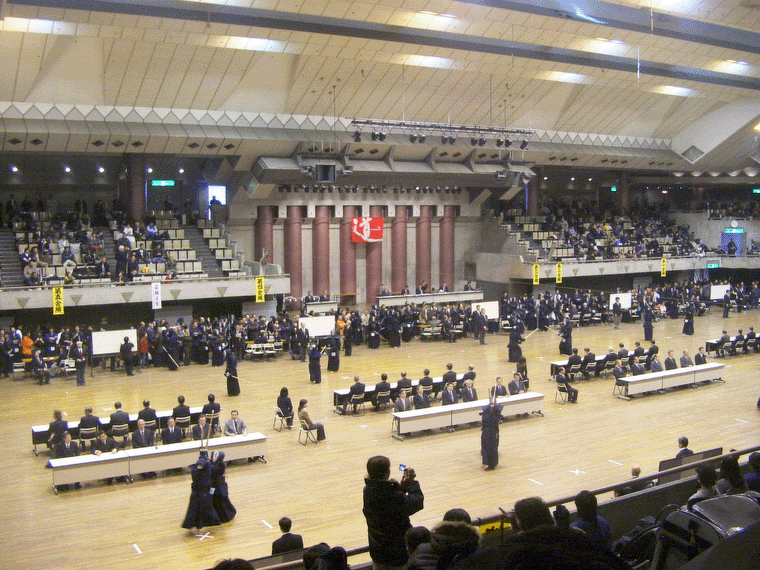Grading orientated uchikomi geiko
In this post I will detail an uchikomi pattern that is being used in our dojo to prepare members specifically for grading exams. It's and excellent exercise and you can adapt it to use for your own grading (or even shiai) preparation, or just to add to your regular keiko program.
This pattern was introduced in our dojo by a visiting Hachidan Sensei (S Sensei) during a number special grading practice sessions which he lead at Michinoko Dojo. These practice sessions we held to help members prepare for upcoming grading exams from 3rd dan to 6th dan. Most of the people will be grading in the Tokyo Budokan (see image below).
You can find a post about S. Senseis other visit toto Michinoko and break down of his kihon keiko here.
You can find a post about S. Senseis other visit toto Michinoko and break down of his kihon keiko here.
 |
| Grading exams in Tokyo are large events, with daily participants often numbering well over 1000. Image from http://www.tokyo-kendo.or.jp/shinsa_kekka/2007-11-45dan-meibo.html |
Uchikomi Pattern.
This uchikomi follows the principal that each cut in keiko should be performed as in a real situation. The motodachi and kakarite should approach the drill with complete focus.
To begin with both players assume their kamae, the motodachi will make a predetermined number of men or kote attacks, to which the kakarite will reply with oji-waza. Kakarite should make seme inviting the motodachi to attack. Motodachi should attack when they feel the pressure from their opponent.
This is a continuous exercise, there is no break when changing roles.
This is a continuous exercise, there is no break when changing roles.
Example set one.
Motodachi - Men, Kote, Men, Men
Kakarite - Debanna men, Ai kote men, Debanna kote, Nuki/kaeshi dou.
Kakarite - Debanna men, Ai kote men, Debanna kote, Nuki/kaeshi dou.
Simply put, motodachi responding to the seme of his opponent attacks with the above attacks. Kakarite attacks with the listed oji-waza trying to score correct ippon each time.
After the four attacks the roles reverse and the pair should move into the next set of four without pause.
S Sensei recommends getting a lot of practice with these four waza to help pass your grading, be it 3rd Dan or 6th Dan. He believes being able to perform these waza at your level will make your shinsa easier.
Example set two.
Motodachi - Men, Kote, Men, Kote, Men.
Kakarite - debanna men, suriage men, debanna kote, kaeshi men, nuki/kaeshi do.
Kakarite - debanna men, suriage men, debanna kote, kaeshi men, nuki/kaeshi do.
This set simply introduces some more waza, suriage men and kaeshi men against a kote strike.
Variations: You can of course make up your own sets, adding or taking away waza, or giving the kakarite a chance to choose their own oji-waza.
Key points
Both should ensure that each cut is made with correct seme, attacking with full spirit and performing zanshin. The feeling of zanshin should be maintained through to the next cut, and should not be released, but instead carried through the entire exercise.
A key point here is that the seme, mind contact and zanshin built up in the exercise should not be broken between attacks or even when the roles change. After making his final oji-waza attack, kakarite immediately becomes motodachi and turns to attack his opponent.
I said above that the exercise is continuous, but this does not mean that it is fast paced. For some there may be a tendency to rush, or for inexperienced motodachi to attack their opponent too early in an attempt to "win". Instead focus on kakarite maintaining zanshin and correctly making seme for each cut.
Thoughts
I think that this is an excellent drill not only for shinsa preparation but also for general practice too. By having the participants focus on maintaining their spirit and zanshin and building up each attack rather than rushing, I believe Sensei's drill can teach us a lot about how to fight our opponents, whether its in ji-geiko, shiai or shinsa.
Question
What kind of practice do you do at your dojo to prepare yourself or your students for grading examinations?
Thanks as always for taking the time to read the blog.
If you have any comments, id love to hear from you.
Follow on facebook: www.facebook.com/DoryokuKendo
Follow on twitter: twitter.com/DoryokuKendo
Tags:
8th dan
dan
drill
examination
exercise
grading
hachi
Hachidan
Kendo
practice
Sensei
Shinsa
uchikomi




1 comments
This comment has been removed by a blog administrator.
ReplyDelete